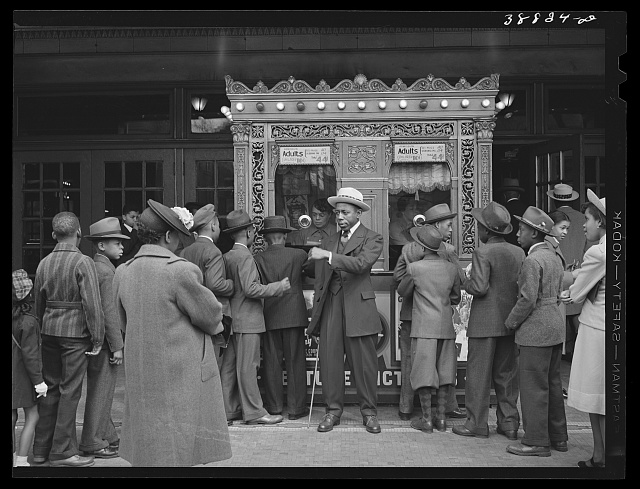Editor’s note: The theme for February 2025, “Celluloid City,” explores the interplay between cities and film. This overview kicks off the month with subsequent pieces by contributors to follow. You can see all posts from the theme here.
Nearly five years ago, The Metropole spent the month of April 2020 thinking about “The Visual City.” Contributors explored the various ways photography, film, and postcards shaped our perceptions of urban life and cities themselves. When it came to the role of film in this regard, The Metropole wrote the following:
Film’s undoubtedly apocryphal origin myth situates its beginnings in an 1895 Parisian basement where the brothers Lumiere projected a series of moving images on a blank screen, which incited equal amounts of terror and excitement among their bewildered audience members. Though Los Angeles would eventually supplant all other cities in regard to film production, during the first few decades of the twentieth century, Paris, Berlin, London, Moscow, and New York all played key roles in its development. From the outset, however, as Barbara Mennel notes, film broadcast the machinations of city life to national and international audiences: “Urban sites – such as the street, the skyline, the bar – were important markers of cities in early cinema.” Cities also served an economic role in two ways: 1) they functioned as critical sites for the larger industry since “capital for production” aggregated in them, and 2) greater profits could be attained by “locating movie houses there because the urban population had ever more expendable income and leisure time.”
Film began in cities and thus has long impacted our perceptions of urban life through cinematic depictions of the same. Movies simultaneously function as a driver and recipient of the economics of the larger show biz industry.
The former however, often obscures the latter. 1976’s Taxi Driver became the embodiment of crime ridden 1970s New York City; He Got Game captured the humidity, dull shine and struggle of both 1994 Coney Island and corruption of college athletics; Heat became an emblem of mid-1990s Los Angeles; The Town, Mystic River, and Good Will Hunting as metonyms for Boston’s white ethnic working class.
It also remains true that just because a film depicts a famous locale, doesn’t mean it’s authentic. Think the cult classic Den of Thieves, a relentless L.A.-centered heist film that robs from its more famous critically acclaimed parent, Heat; its dialogue and atmosphere couldn’t be more SoCal, yet it was filmed in Atlanta. Or take Stanley Kubrick’s Eyes Wide Shut. The English director who refused to decamp from the English capital transformed holiday season London into a Christmastime New York all in the context of marital infidelity and unrequited sexual passion. In Full Metal Jacket, Kubrick swapped Vietnam for East London. You get the idea.
Needless, to say these are not inconsequential matters, but they also speak to film’s role in shaping cities economically. Kubrick’s productions drove the industry in London. In North America, Atlanta and Vancouver often serve as more affordable stand-ins for a great number of cities while supplementing Hollywood’s larger industry. In 2016, according to data from the Los Angeles film office, more films were made in Georgia than California and Time subsequently referred to Georgia as Hollywood’s “southern campus.” Vancouver (also known as Hollywood North) is the third most common filming location in North America. In 2018, the British Columbia metropolis brought in over $3.4 billion from film production.
Internationally, Lagos, Nigeria and Mumbai, India, home to Nollywood and Bollywood, respectively, house enormous movie industries that have shaped audiences and their perceptions of urbanity across Asia, Africa, and the North America. Though facing complications from China’s takeover of the island and increasing competition from the mainland, Hong Kong has also long been a source of international cinema, including the work of innovators like John Woo and Wong Kar-wai. Woo and Kar-wai have both shaped my ideas about cities and apparently also shaped Quentin Tarantino, who has drawn upon the work of both auteurs in his own films.
Whether through portrayals of a specific city, the promotion of theories on urban growth, governance, architecture, policing and other political issues, or even the real-world policies adopted by municipal governments to draw and manage film production, there are numerous ways in which movies and movie-making influence the world’s metropolises. This month’s contributors delve into this complex history in “Celluloid City” and in doing so traverse continents and time, exploring the architecture of ancient Rome as depicted in Gladiator II, film’s place in shaping India’s urban life following independence, the attempt by one Harlem filmmaker to combat negative perceptions of the community after World War II, George Romero’s adoption of Pittsburgh as the metropolis of the undead, and engage the utopian city with an exploration of Francis Ford Coppola’s Megalopolis. It should be a great month, maybe even in moments, the type of month that dreams are made of?
Featured image (at top): Entrance to movie theater. Southside of Chicago, Illinois, Lee Russell, photographer, April 1941, Prints and Photographs Division, Library of Congress.

